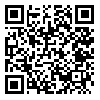Volume 11, Issue 41 (4-2002)
JGUMS 2002, 11(41): 7-12 |
Back to browse issues page
Abstract: (10079 Views)
The production, distribution, and consumption of iodized salt have increased in recent years. Also, a mild increase in the incidence of hyperthyroidism has been described previously and following implementation of iodinated salt programs, reinforced by other reports. Therefore, this study was carried out to assess iodine status in men and women aged more than 40 years in Tehran in 1996.
In a cross sectional study in Tehran, 741 women and 514 men over 40 years of age were selected randomly. Thyroid size was examined by palpation and graded according to the WHO classification. Urinary Iodine was measured by digestion method. Serum T4, T3, and TSH (IRMA) concentration were also assayed by kits.
In 211 men and 367 women aged 40-50 years old, percentage of grades 1 and 2 goiter were 53% and 22% in men and 53% and 35% in women, respectively. In 303 men and 374 women over 50 years old, percentage of grades 1 and 2 goiter were 50% and 14% in men and 51% and 23% in women respectively.
The mean urinary iodine was 17±5.4 µg/dl. In 87% of the subjects, urinary iodine was more than 10 µg/dl.
Mean serum T4, T3 and TSH were 8.4±1.3 µg/dl, 168±35ng/dl, and 1.4±0.7 µu/ml, respectively. Combination of high T4, T3 and suppressed TSH were observed in 2 subjects.
This study points to the adequacy of iodine intake. The prevalence of hyperthyroidism has not been increased.
Review Paper: Research |
Subject:
Special
Received: 2014/09/28 | Accepted: 2014/09/28 | Published: 2014/09/28
Received: 2014/09/28 | Accepted: 2014/09/28 | Published: 2014/09/28
| Rights and permissions | |
 | This work is licensed under a Creative Commons Attribution-NonCommercial 4.0 International License. |


